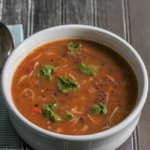
Middle Eastern Chickpea and Broken Noodle Soup
This soup saves time by using a pressure cooker to cook the chickpeas. Homemade chickpeas are tastier than canned, but more importantly, the cooking stock adds flavor and depth to the broth of the soup. For me, the beauty of the pressure cooker is being able to decide to cook the beans about an hour before serving dinner--so my beans are not soaked, but if you are even shorter on time, soak the chickpeas the night before and consult your pressure cooker manual for cooking time as it will considerably reduce it. Use vegetable stock to make vegetarian.
Ingredients
For the pressure cooker:
- 1 lb dried chickpeas
- 1 large yellow onion, chopped
- 1 T extra virgin olive oil
- 1 T minced garlic
- water to cover by about 3 inches
For the soup pot:
- 2 T extra virgin olive oil
- 2 t cumin seeds
- 2 large yellow onions, chopped
- salt to taste
- 2 medium carrots, diced
- 2 T minced garlic
- 1 t allspice
- 1 t ground cumin
- 2 t urfa chile pepper*
- 2 T double strength tomato paste (use 1/4 cup if regular strength)
- 2 t pomegranate molasses, plus more later
- 6 cups chicken stock (use vegetable stock for vegetarian)
- chickpeas plus cooking liquid from pressure cooker
- 2-3 cups broken vermicelli
- juice of one lime or lemon
- 1 t cured sumac,* plus more later
For serving:
- lemon or lime wedges
- sprinkle of cured sumac
- Central Asian Herb Paste (if unavailable, use chopped cilantro and mint)
Instructions
Start the chickpeas in the pressure cooker:
-
Rinse and drain the dried chickpeas. Place them in the pressure cooker with the chopped onion, minced garlic and extra virgin olive oil.
-
Cover the chickpeas with water by 3 inches. Seal the pressure cooker according to directions. Cook for 35-40 minutes on high pressure.
-
Let cool down naturally for 10 minutes. After that, if you are ready for the beans you can speed the cooling process by using the quick pressure release.
While the chickpeas are cooking, begin the soup:
-
In a large soup pot or Dutch oven, heat the 2 tablespoons of extra virgin olive oil over medium heat. When it is hot, add the cumin seeds and let roast, until darkened and fragrant, 1-2 minutes.
-
Add the chopped onion with a pinch of salt. When adding salt to this dish, be aware of whether you are using low salt broth, "regular" commercial broth, or a homemade broth with no salt.
-
Let the onions cook for about 7 minutes, stirring occasionally. Add the carrots and cook another 5 minutes. Add the garlic and cook for 2-3 more minutes.
-
Add the ground allspice, cumin and urfa chile pepper with the tomato paste. Stir and let the spices roast and become fragrant, but do not let them burn. Add the pomegranate molasses and mix it in.
-
Add the chicken or vegetable stock. If it is unsalted, add a teaspoon of salt. Scrape the bottom of the pot to completely deglaze the pan and then bring to a boil. Cover and reduce the heat to a gentle simmer.
-
Let the soup simmer and the flavors meld while the chickpeas finish cooking.
-
When the chickpeas are finished cooking, add a teaspoon of salt to the chickpeas and stir it in. Then add the chickpeas, including their cooking broth, to the soup.
-
Bring the soup back to a boil and reduce to a simmer so the flavors can continue to meld while you add the finishing touches.
-
First, add the broken vermicelli. It will cook in the broth. Mix in the cured sumac and the juice of one lime or lemon (either will work, just stick with whichever you decide).
-
Taste for salt and add more if needed. You can also add more pomegranate molasses, lemon or lime juice and sumac if any of those sound good.
-
Serve the soup when the broken vermicelli is cooked. Serve garnished with lemon or lime wedges, a sprinkle of the cured sumac and dollops of the Central Asian Herb Paste.
Recipe Notes
*This is another recipe where I had fun playing with spices from Burlap and Barrel. This post is not sponsored, I just really like their stuff! If you cannot use their spices, substitute with regular Urfa pepper and regular sumac.